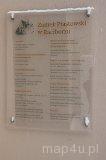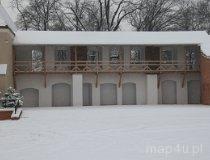Piast Castle in Racibórz - Station 01 - The Courtyard
Description
Welcome in the area of Piast Castle in Racibórz. This medieval seat of the Princes of Piast is today one of the most valuable monuments of Silesian province. The application with the audio guide will lead you through the most interesting parts of the castle and objects associated with it and it will talk about the rich history of this place. The entrance to the chapel and to the interior of Dom Książęcy (Prince’s House) is possible only with a guide. Detailed information about visiting the interior are provided by the Tourist Info Point, located at the gate. The entire route has 12 stations. The first one is situated in the courtyard of the castle.
You entered the terrain of the castle through the gate (photo 10.01.001). From the city side above the entrance there is a stone coat of arms of Racibórz county (photo 10.01.002). The golden eagle on a blue background refers to the coat of arms of the Piast of Upper Silesian, and the vertically divided white and red stripes, to the coat of arms of Przemyślidzi opawscy. At one time the two clans ruled the Racibórz castle. In the gate there is a Tourist Information Centre, where you may buy souvenirs, postcards and tickets to the castle. While crossing, you may also notice the Gothic arch (photo 10.01.003), reminiscence of the medieval past of the building. This passage leads straight into the courtyard. At the entrance there are two information boards. It is worth to look at them because at the right side is a map of the structure (photo 10.01.004), and, on the left, it shows the manager and the company that carried out the reconstruction of the castle (photo 10.01.005).
The main courtyard is built on three sides. Next to the door is the most precious monument of Piast castle: the 13th century chapel of St. Thomas Becket of Canterbury. (Photo 10.01.006). Behind it you will see the Dom Książęcy (photo 10.01.007), preserved in its original state, with the cloister with decorative beams supporting the roof (photo 10.01.008). The elevated part of the Prince’s House is not plastered, and thanks to that stone foundation and historical arrangement of bricks are visible (photo 10.01.009) as well as stone jambs (photo 10.01.010). The northern wing of the castle is destined to the Castle Brewery (photo 10.01.011), and inside there are huge boiling vats. Also the west wing building was associated with beer production (photo 10.01.012). Once there was the malt, but now the building is adapted to cultural purposes, as it is planned to move here the Młodzieżowy Dom Kultury (Youth Culture House) and create a small hotel with a restaurant in the basement. On the west side is preserved a fragment of the defensive wall (photo 10.01.013), so that you can get to know the materials from which it was built as well as the technique for erecting fortifications. The south side is not built-up. So nothing obstructs the view of the river Odra and the Old Town. In the eastern part of the castle was once the bastion; nowadays, there is only a reconstructed fragment (photo 10.01.014). Inside, the tower, unavailable to visitors, descend to the subterranean levels (photo 10.01.015). Legend has it that an underground tunnel under Odra river leads from here to the former Dominican monastery, now a municipal museum in Racibórz. This legend is confirmed by a map of Racibórz dated 1843, found during the renovation of a fleche on the roof of the chapel. On this map there is a thin line connecting the castle to the monastery. The bastion is connected with the gateway by the well-preserved wall of the former residential building. In the courtyard, a reconstruction of a well standing in the middle attracts tourist’s attention. (photo 10.01.017). There is a legend connected also with it. Once, on the corner of a residential building, was a stone head. Legend says that it represented one of the Tartar chiefs, who, in the 13th century, was defeated exactly in this place. The sight of this figure was directed to the treasure hidden in the well by the Mongols. There are also those who believe that the Tatar looks at the treasure, not the one in the well, but the one produced in the local brewery. The head itself is now in very poor condition and is located in the municipal museum. Historians, however, refute the legendary theories and argue that the stone sculpture most likely presented St. John the Baptist. There are a lot legends associated with the castle, but let’s move to the, nonetheless interesting, true story of Piast castle.



.jpg)
.jpg)
.jpg)
.jpg)

.jpg)
.jpg)
.jpg)
.jpg)
.jpg)
.jpg)
.jpg)
.jpg)
.jpg)
.jpg)

.jpg)